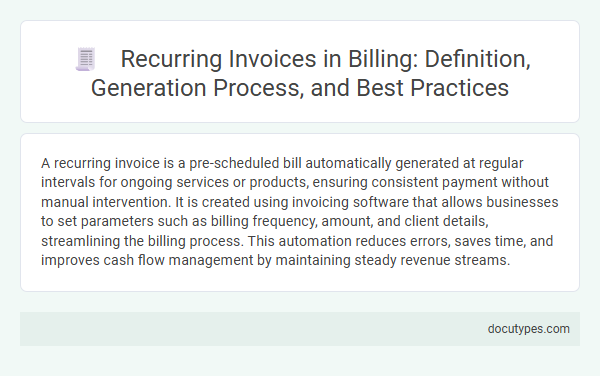A recurring invoice is a pre-scheduled bill automatically generated at regular intervals for ongoing services or products, ensuring consistent payment without manual intervention. It is created using invoicing software that allows businesses to set parameters such as billing frequency, amount, and client details, streamlining the billing process. This automation reduces errors, saves time, and improves cash flow management by maintaining steady revenue streams.
Introduction to Recurring Invoices
A recurring invoice is a billing document sent to customers on a regular schedule, such as weekly, monthly, or annually. It automates the invoicing process for services or products provided continuously over time.
Your business saves time and reduces errors by using recurring invoices, ensuring consistent cash flow. These invoices are generated based on predefined intervals and amounts, often through accounting or invoicing software. Automation simplifies managing subscriptions, memberships, or ongoing service contracts efficiently.
What Are Recurring Invoices?
Recurring invoices are bills sent to customers on a regular, scheduled basis for ongoing products or services. They automate the billing process, ensuring consistent cash flow and reducing manual work.
Common in subscription-based businesses, recurring invoices include details such as customer information, payment terms, and the billing cycle. Generation typically involves software that automatically creates and sends these invoices according to predefined intervals.
Key Components of a Recurring Invoice
A recurring invoice is a regular billing document sent automatically to customers for ongoing services or subscriptions. It saves time by generating invoices without manual input each billing cycle.
- Customer Information - Includes the name, address, and contact details of the recipient to ensure accurate delivery.
- Billing Schedule - Defines the frequency and dates when the invoice is automatically created and sent.
- Itemized Charges - Lists all products or services with quantities and prices to provide clear payment details.
Benefits of Using Recurring Invoices in Billing
| What Is a Recurring Invoice? | A recurring invoice is a billing document automatically generated at regular intervals for ongoing services or products. It ensures consistent payment requests without manual intervention, streamlining the billing process. |
|---|---|
| How Is a Recurring Invoice Generated? | Recurring invoices are created using billing software or invoicing platforms that allow preset schedules for delivery. Users specify invoice details, frequency (weekly, monthly, yearly), and client information, enabling automatic dispatch based on predefined criteria. |
| Benefits of Using Recurring Invoices in Billing |
|
Common Use Cases for Recurring Invoices
A recurring invoice is a billing document generated automatically at regular intervals for ongoing services or subscriptions. It simplifies payment collection by eliminating the need for manual invoicing each billing cycle.
Common use cases for recurring invoices include subscription services, such as software-as-a-service (SaaS) platforms, utilities, and membership fees. They are also widely used by freelancers and agencies providing monthly retainers or continuous project support.
How Recurring Invoices Are Generated
A recurring invoice is a billing document automatically sent to customers at regular intervals for ongoing services or subscriptions. The generation of recurring invoices involves setting predefined parameters such as billing frequency, amount, and recipient details within invoicing software. Once configured, the system automatically creates and dispatches invoices without manual intervention, ensuring timely and consistent billing cycles.
Essential Steps in the Recurring Invoice Process
A recurring invoice is a billing document automatically generated at regular intervals for ongoing services or subscriptions. It simplifies revenue tracking and enhances cash flow stability for businesses with repeat customers.
- Define Billing Schedule - Establish the frequency such as weekly, monthly, or annually based on the service agreement.
- Set Invoice Parameters - Input client details, payment terms, and amounts to automate consistent invoicing.
- Automate Generation and Delivery - Use accounting software to automatically create and send invoices without manual intervention.
Best Practices for Managing Recurring Invoices
A recurring invoice is a billing document automatically generated at regular intervals for ongoing services or subscriptions. It simplifies consistent payment collection without needing to recreate invoices manually each time.
- Automate Invoice Scheduling - Set up your billing software to generate invoices on predetermined dates to ensure timely billing cycles.
- Maintain Accurate Customer Records - Keep client information updated to avoid billing errors and improve payment reliability.
- Monitor Payment Status Regularly - Track paid and outstanding invoices to manage cash flow and identify late payments promptly.
Implementing these best practices can streamline your invoicing process and enhance financial management efficiency.
Common Challenges and How to Overcome Them
A recurring invoice is a regularly scheduled billing document sent to clients for ongoing services or subscriptions. Generating these invoices typically involves automated software that schedules and issues invoices based on predefined intervals. This process ensures consistent cash flow and reduces manual workload for businesses.
Common challenges with recurring invoices include missed payments, inaccurate billing details, and difficulty managing subscription changes. These issues can disrupt revenue streams and harm client relationships. Effective strategies involve using reliable invoicing software with payment reminders and integrating customer management systems to maintain accurate records.
Overcoming these challenges requires proactive monitoring of invoice statuses and clear communication with clients about billing cycles. Automating updates for subscription modifications helps maintain invoice accuracy. Your business benefits from streamlined billing processes that minimize errors and enhance customer satisfaction.
What Is a Recurring Invoice and How Is It Generated? Infographic

